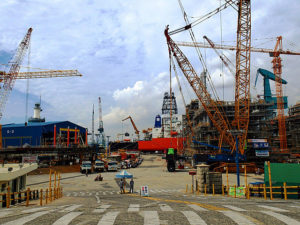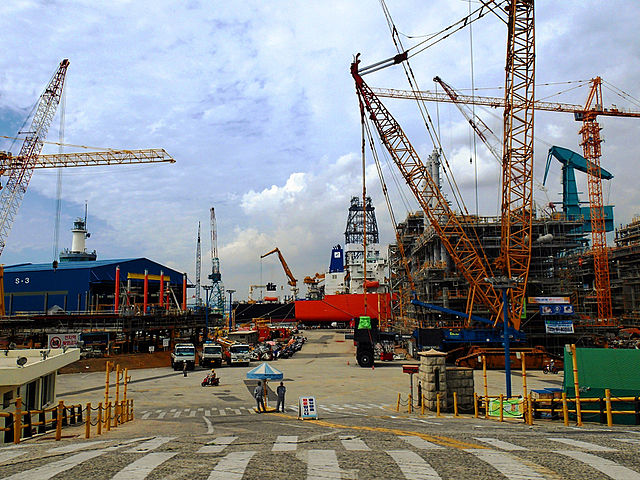 The South Korean government has announced a sweeping industrial restructuring plan to stave off the deterioration of the local shipping industry, including massive orders for new ships with domestic shipyards and a financing program for the cash-strapped liner shipping industry.
The South Korean government has announced a sweeping industrial restructuring plan to stave off the deterioration of the local shipping industry, including massive orders for new ships with domestic shipyards and a financing program for the cash-strapped liner shipping industry.
This comes as five bidders have reportedly placed initial tenders for Hanjin Shipping Co.’s Asia-U.S. route, with the asset sale by the country’s bankrupt shipper expected to be completed by next month.
As part of a plan to stimulate the ailing shipbuilding sector, South Korea’s government and public entities will place orders for more than 250 ships, worth about KRW11 trillion (US$9.59 billion), with domestic shipyards by 2020, Yonhap News reports.
For shipping firms, on the other hand, it will extend as much as KRW6.5 trillion in fresh financing to help boost their competitiveness, Finance Minister Yoo Il-ho said on October 31.
Infusion of new shipyard orders
“The world’s shipbuilding industry is expected to suffer shrinking demand until 2020,” Yoo said at a ministerial-level meeting in Seoul that finalized the rescue program. “In order to deal with an order shortage, the government will help shipyards receive new orders for 250 or more vessels, worth 11 trillion won, by 2020 from the public sector.”
He said the government will also push the shipbuilders to reorganize their business portfolios in the longer term, focusing on higher value-added ship services.
He said Daewoo Shipbuilding & Marine Engineering Co., which has been under a creditor-led workout program, will seek a new owner after undergoing strict downsizing and managerial reform.
“The government is aiming to privatize the shipbuilder in the end,” Deputy Trade Minister Toh Kyung-hwan said in a briefing. “But before privatization, the company should normalize its management first, through disposing of under-performing businesses and improving more competitive sectors.”
He said the timing of the sale will be decided later in accordance with market conditions.
According to the government, the country’s so-called Big 3 shipyards plan to cut their workforces to some 42,000 by 2018 from the current 62,000, with their combined docks to be reduced to 24 from the current 31.
Hyundai Heavy will spin off its non-shipbuilding businesses, such as wind power and other alternative energy-related businesses, and Samsung Heavy will sell property such as hotels, while Daewoo Shipbuilding plans to cut 5,500 jobs by 2018, according to the government.
The state said the shipbuilders’ business portfolio will be rearranged to focus on large container ships, oil tankers, and LNG carriers.
To normalize Daewoo Shipbuilding, a joint panel of government officials and creditor banks will approve the company’s ship orders after reviewing their profitability and feasibility, said the official.
Efforts will go to working on advanced vessels that are environment-friendly and services like ship maintenance and design, said Yoo.
The government will also spend KRW1.7 trillion by 2017 to boost the local economy of the coastal regions where big shipyards are located, while injecting an additional KRW1 trillion over the next five years to create various public works projects in the affected coastal areas.
South Korean shipbuilders have been under severe financial strain since the 2008 global economic crisis, which sent new orders tumbling amid a glut of vessels and tougher competition from Chinese rivals.
Credit extended to shipping lines
Meanwhile, the KRW6.5 trillion in financing program for the shipping industry has come as the collapse of Hanjin Shipping Co. caused a worldwide logistics disruption and a drop in cargo handled at the country’s seaports.
The government will create a new company, tentatively named “Korea Shipping Co.,” in the first half of next year to take over container ships from ailing shipping lines and lease them back to the shippers to help them stay afloat.
The state-run policy lenders, including the Korea Development Bank, will finance 80% of the company’s total assets of KRW1 trillion.
Also, a fund designed to help small shippers borrow vessels run by the government-owned Korea Asset Management Corp. will be expanded to KRW1.9 trillion by 2019.
5 initial bids for Hanjin
In related news, Hyundai Merchant Marine Co., the Korea Shipping Association, Korea Line Corp., local private equity fund Hahn & Co., and an unidentified investor have submitted their preliminary bids for Hanjin Shipping’s lucrative Asia-US route asset, according to another report by Yonhap News. Final bids are due by November 7.
Hanjin Shipping, currently under court receivership, is seeking to sell its assets in an effort to survive an industry-wide slump and cash shortage.
Earlier Hanjin Shipping said it is working to wind down its European operations, raising speculation that the country’s No. 1 shipper is preparing for liquidation.
The shipper also said it would sell its stake in a US affiliate that operates a terminal in the Port of Long Beach, California, as part of efforts to raise the cash needed to stay afloat.
Hanjin Shipping was put under court receivership early last month as its creditors, led by the state-run Korea Development Bank, rejected its last self-rescue package worth KRW500 billion, which fell short of the KRW700 billion demanded.
Photo: SarahTz from Richmond, United Kingdom – Hyundai Heavy Industries ship yard, South Korea





